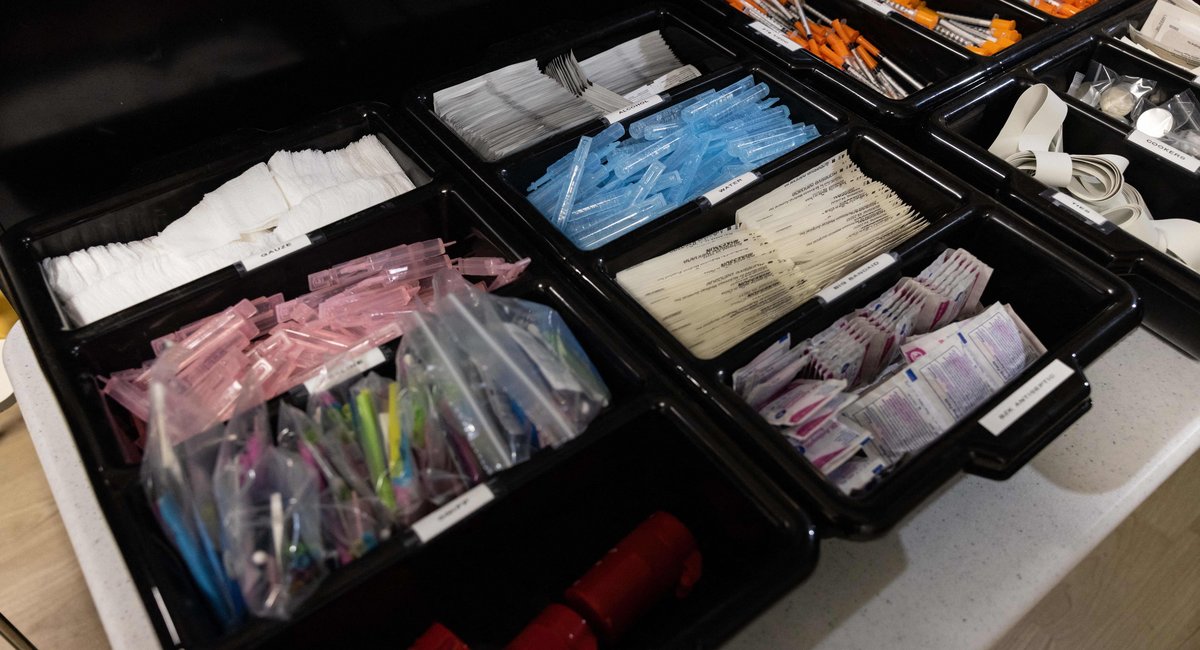New York City plans to spend money it has received from legal settlements with opioid manufacturers faster as it looks to increase addiction services and lower the city’s stubbornly high rate of overdose deaths, Mayor Eric Adams said Tuesday.
To date, the city has received $154.3 million from city and state settlements with pharmaceutical companies that have been accused of exacerbating the opioid crisis. The mayor’s office said the funding pool is expected to grow to $500 million by 2040.
The city allocated $33 million of the settlement funds to addiction treatment and other efforts to prevent overdose deaths last fiscal year. Adams said he wants to raise spending to roughly $50 million annually over the next four years.
The opioid settlement funds will go toward uses that include expanding services offered at syringe exchange programs, supporting treatment programs at public hospitals and upgrading the forensic toxicology lab at the Office of the Chief Medical Examiner, according to the mayor’s office.
Adams’ update on opioid settlement spending comes as his administration faces pressure to show progress in lowering the city’s sky-high overdose rate, which continues to take its biggest toll in low-income neighborhoods in the Bronx. More than 3,000 New Yorkers died of an overdose last year, about twice the number reported in 2019, according to the U.S. Centers for Disease Control and Prevention.
Some advocates working to address the overdose crisis have also recently slammed the city for not providing a detailed enough accounting of how it is spending the opioid settlement dollars.
In response, Erika Tannor, a spokesperson for the mayor’s office, said on Tuesday that the city is “laying out our plans for the next tranche of settlement funds in great detail.”
Tannor also pointed to the city’s latest quarterly report on settlement funding, which provides figures on how many New Yorkers were served by a handful of the programs the money supports.
“This money will continue to fund evidence-based strategies and today’s announcement adds even more clarity to how the Adams administration is acting decisively to support programs across the substance use care continuum, including harm reduction, treatment and community support,” Tannor said.
The city has yet to detail how much money is going toward individual programs and facilities, making it hard to tell how much of the funding is targeting services in the hardest-hit parts of the Bronx. But the latest update highlights some of the programs that will be supported by the settlement dollars in the coming years.
By fiscal year 2027, public hospitals will receive $22 million annually from the settlement dollars for services such as “addiction response teams,” according to the city. The city is launching the model at hospitals in the Bronx, Queens and Harlem to provide patients addicted to opioids with rapid access to medication and help them connect to longer-term treatment, according to the mayor’s office.
It’s one of several similar programs that have launched at public hospitals in recent years, which aim to engage people in treatment as they pass through emergency rooms or are admitted to hospitals.
Settlement dollars will also go toward opening a new $8 million treatment facility for expecting parents at Lincoln Hospital in the Bronx in 2026, according to the city.
Another $24 million annually will flow through the city health department by fiscal year 2026 to expand treatment and harm reduction services at various organizations. That includes the Relay program, which uses peers who have their own experiences with addiction to engage people in services after they survive an overdose.
The Office of the Chief Medical Examiner will receive $4 million annually to improve equipment and staffing in its toxicology lab and continue to support its Drug Intelligence and Intervention Group, which offers support to families of people who recently died of an overdose.
Gothamist recently reported a shortage of medical examiners that has led the Office of the Chief Medical Examiner to stop performing autopsies on every overdose death. Asked whether the opioid settlement funding would help address that shortage, chief medical examiner’s office spokesperson Julie Bolcer said the office “continues to investigate every suspected overdose death with thorough toxicology testing and this investment will fortify that ability by directly funding the addition of more scientists, new equipment and upgrades to the laboratory.”
At the state level, an Opioid Settlement Fund Advisory Board offers recommendations on how a separate pool of settlement dollars controlled by the Hochul administration should be used, but no similar body exists to weigh in on spending in New York City. Some members of the state board have recently called for New York City officials to make a detailed presentation on how the local settlement dollars are being spent, according to the news outlet The City.
Tannor said the city has “robust transparency measures in place to inform the board and the public about where this settlement funding is going.”
